
In Love With Dutch Gap (part 1)
January 11th, 2018
Michael and I spent a week in Virginia this Christmas, sharing the holidays with my parents. And I managed three outings to Dutch Gap, each of them wonderful in its own way.
Dutch Gap is a conservation area on the James River and one of my favorite places in the world. A rather superlative statement, I know, especially for someone who has birded Costa Rica, but Dutch Gap is special to me. In summer, it's about the beautiful Prothonotary Warblers, brilliant golden birds who nest in tree holes in wooded swamps. At Dutch Gap they nest in bird boxes built especially for them, erected six feet or so above the water. You seem to hear their song around every corner. And they are easy to see, at least until you take your camera out.
But this time of year it's about the ducks. A diverse and abundant assortment of them winter in the marshes of Dutch Gap, viewable right from the roadside. They can sometimes become quite tame. My high counts this trip included, among others, 40 American Wigeons, 100 Gadwall, 10 Northern Pintails, 40 Northern Shovelers, and a whopping 160 Wood Ducks. (Those counts are all loose but conservative, based on what I could see with binoculars and spotting scope from the various overlooks. There were doubtless more!)
I guess ducks are some of my favorite birds. They have such character about them. The gentle Gadwalls, the stern yet comical Ring-Necked Ducks, the ungainly Shovelers. And for the first time I was able to capture them well. I fell in love anew with each species as I was processing their photos.
My first outing, on the 23rd with Michael, had me in a sorry state. I was worn out from travel and having difficulty adjusting to being away from home. But the marshes lifted my spirits.

A Northern Shoveler dabbles for food with his oversized bill, while another tips up. There were dozens of them swimming close in that day.

Northern Shovelers have comb-like structures called lamellae on the edges of their oversized bills. As they dip their bills in the water, the lamellae strain out tiny crustaceans and other food items.
I noticed a few of them doing something I'd never seen them do before. Two ducks would slowly spin together while dabbling, creating a gentle vortex with them at its center. It was reminiscent of what phalaropes do, and likely for the same purpose (to draw food items up to the surface), but the shovelers preferred to do it in pairs. Visually they reminded me of a yin yang.
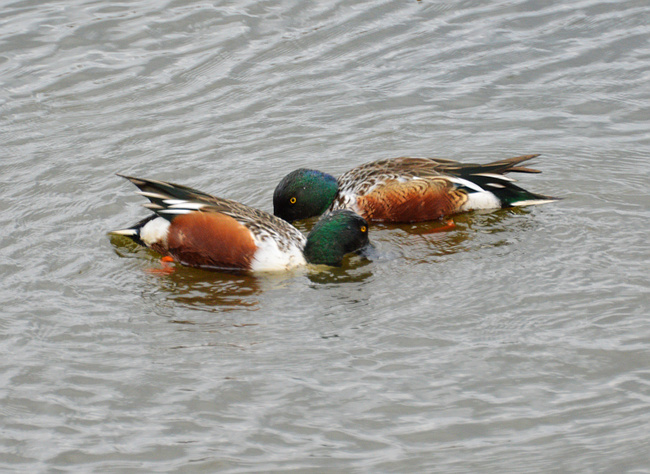

Note the vortex around this fellow. I think this is one who was spinning by himself.
The other stars of the day were the Ring-Necked Ducks. These diving ducks like shallower water than their relatives, and often hang out with dabblers in marshes and ponds, while the more dedicated divers keep to rivers, lakes and ocean bays. I had struggled to do the shovelers justice in the overcast lighting that day, but for the ring-neckeds it was no problem at all. They're naturally monochrome.



(If you're wondering why these ducks are called "Ring-Necked" and not "Ring-Billed", you're not the first. They do have a very subtle chestnut ring around their necks, visible at close range--as in, to someone who is holding a specimen in their hands. It is seldom seen by the rest of us.)
( More (American Coot, squabbling gulls) )
Life Bird #473
December 21st, 2017
(Part 1)
The next day I tried again and hit gold. The Black-Throated Gray Warbler appeared east of the ridge. Many birders that day enjoyed good views and, for the camera-equipped, photo ops as it actively foraged in a stand of buckthorn.
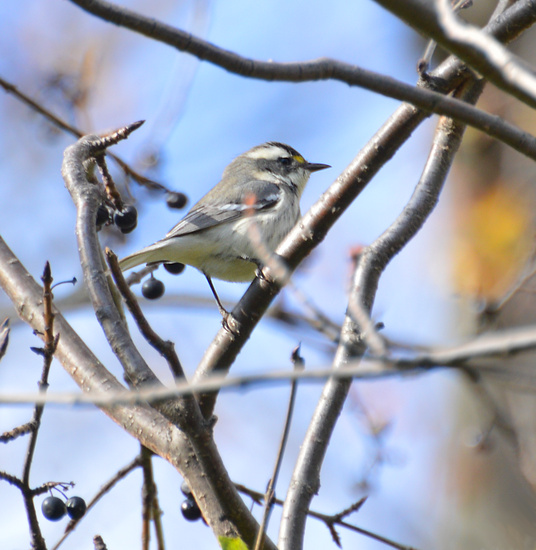
Black-Throated Gray Warbler breeds in the west from Arizona and New Mexico, up to the southwestern tip of British Columbia. It prefers pine and mixed oak-pine forests. Like most warblers, it is a dedicated insectivore (although, as suggested by its attraction to buckthorns at Mud Lake, it will also take the occasional berry.) This bird is often considered part of a "superspecies" with the closely related warblers Black-Throated Green (our local representative), Townsend's, Hermit, and Golden-Cheeked. It is the least colorful of the bunch (unsurprising for a southwest bird), but still has a certain somber handsomeness about it and a little spot of color, especially on the breeding adult male. The one in Ottawa was probably a young (first-year) bird.
Sadly, but not unexpectedly, this lost waif was not able to contend with an Ottawa winter. It did surprisingly well for awhile, until the big snow arrived. That morning, Bruce di Labio went to Mud Lake and found it lying motionless at the base of a tree. He picked it up and cradled it in his hand to try to warm it, but it was too late. A silver lining on the cloud is that now the Royal Ontario Museum has a specimen for a very rare bird in our region.
I find it interesting that the same man who found the warbler was the man who was there to try to rescue it in its final moments. It was the same with the Bullock's Oriole in Pakenham: Ray Holland found it, and Ray Holland was there to rescue it when the winter turned harsh. (And for the oriole the ending was happy: it was eventually released in British Columbia after convalescing at the Wild Bird Care Centre.) Even though many, many people went to see both birds, those men were there when it counted. It speaks to their dedication and their skill as field-naturalists.
And now for more photographs from Mud Lake.
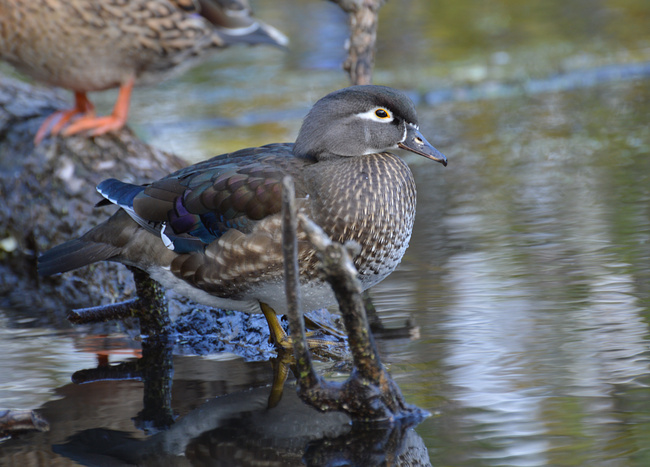
Wood Duck (female)

Wood Duck (male)

Northern Cardinal

Dark-Eyed Junco

Fox Sparrow
Fox Sparrows only appear in Ottawa in migration. This one was a little late moving on to its wintering grounds (but much better able to deal with being late than an insectivorous warbler.) It was in with a group of White-Throated Sparrows and Dark-Eyed Juncos, all coming out to forage on birdseed that someone had scattered on the trail. But it was much shyer than they, quickly darting back undercover whenever a human got close. I've only managed a few photos of this bashful sparrow (one of my favorites) over the years, and I still haven't gotten one that I'm truly happy with.
Catching Up
December 20th, 2017
It's time--long past time, really--for a catch-up post, before Michael and I head to Virginia for Christmas vacation. (I'm going to be rambling a bit for the next five paragraphs, so click here if you prefer to skip straight to the photos.)
Like last year, I've ramped down my nature photography for the cold season. When I do manage to coax myself out into the Ottawa winter, my focus is on seeking beauty and enjoying it in the moment (rather than taking myself out of the moment to capture it), and getting enough exercise to stave off seasonal affective. However, I made two trips out to Mud Lake in early November in search of an ultra-rare Black-Throated Gray Warbler, and I brought the camera both times. I'll share those photos in this post and the next.
And the camera will be going with me to Virginia. I very much look forward to seeing the incredible array of wintering ducks at Dutch Gap, and maybe capturing them. Chesterfield had t-shirt weather today. I can only hope it will offer some of the same after our arrival! And I can only hope the trip works out and lasts long enough to catch Virginia at its best. I have been having major sensory processing issues, which more or less torched my last attempt at travel (Point Pelee in May.) I'm tired of not travelling due to these issues--as much as I love my home city, I'm tired of only seeing Ottawa birds.
I'm eBirding these days. (That's a link to my eBird profile, but note that you have to be registered on eBird to view it.) i.e. reporting the results of my birding outings (and sometimes feeder watches) to the huge public database run by Cornell. This is increasingly popular among birders, and increasingly being used by scientists for tracking the distribution of species around the globe.
Relatedly, I've been working on a program for recording bird sightings locally (i.e. on my own computer) and personally. It's sort of eaten my life, though in a good way. I've enjoyed the coding, and finally, now, am enjoying the fruits of it. The nucleus of the idea was my dissatisfaction with eBird's query abilities and its impersonal nature. Although I'm not going to stop eBirding, I wanted in addition something more like Birder's Diary, but that runs natively in Linux (my preferred platform.) I wanted to be able to easily ask, for instance, "where have I seen Scarlet Tanager in June and July?" And I wanted a platform for storing personal thoughts about my birding trips, not just dry scientific data.
I now have all these things in BirdDB! It's a Perl library with a terminal-based app running on top, and my next step will be a GUI app. I haven't decided yet whether I will ever release any of it for public use. I don't know how big of an intersection there is between the already small groups "serious birders for whom eBird isn't enough", and "linux geeks." I suspect not a big one. (Besides, there is actually already a birding program that runs on linux. It's in Java. The truth is I made BirdDB more because I really wanted an interesting programming project, than because there were no existing alternatives.)
So a Black-Throated Gray Warbler showed up in Ottawa, our second ever. It is a bird primarily of the American southwest, though its range does tip up into southernmost British Columbia. It should have flown to Mexico in fall, instead, somehow, it ended up here. It was first found on the second of November at Mud Lake, and ended up lingering there until mid-December, when winter came in with a vengeance.
The afternoon of the day it was first reported, a rainy afternoon, I went to Mud Lake and soaked myself and my optics to the bone looking for it. No dice. I settled for photographing common birds, and promised myself I would be back the next day to try again.
Note: Husband and I finally got a new 1920x1080 monitor, so that's the res I use for wallpapers now. Click through to the gallery for wallpaper links for the first and third of these.

Downy Woodpecker

Northern Cardinal
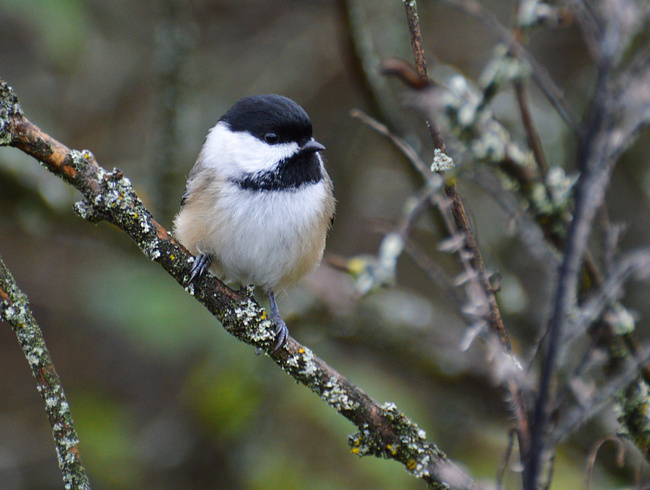
Black-Capped Chickadee
(Continued in next post.)
A Wet Morning On The Tracks
August 12th, 2017
On July 4th I headed to Huntmar Drive intending to hike the west side of South March Conservation Forest. But I found the Carp River swollen and flooded from our heavy rains, with tantalizing water bird calls coming from within: Pied-Billed Grebe, Northern Waterthrush (it's certainly been The Summer of the Waterthrush for me), Virginia Rail. It was so flooded that the lot where I used to park for South March was under at least a foot of water. A Great Egret flew over heading for the river, followed by a Great Blue Heron. I decided to hike down the train tracks and bird the flood instead of the forest!
Unfortunately the water birds remained largely unseen. But I still found a few things worth photographing. The unexpected stars of the day were the snails. They were pretty up close, at least some of them (their shells ranged from pale yellow to vivid amber), but a little gross in terms of numbers. I've never seen so many snails. There were about as many snails on the railbed as there were pieces of gravel.
I chose this beauty for a closeup:

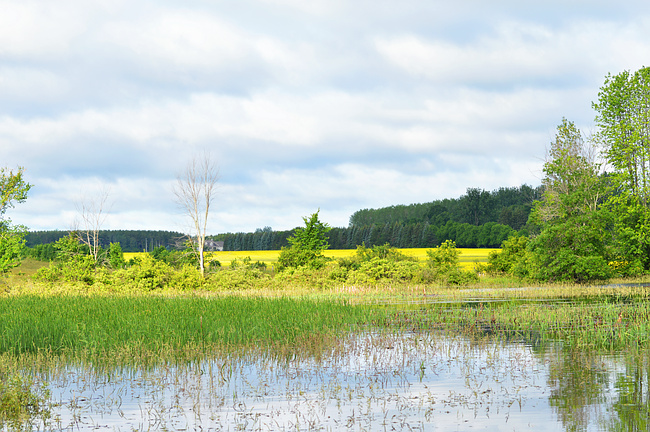
Looking out over Carp River wetlands and beyond. The field was even more vividly yellow than it appears here (a Canola crop?) I think Huntmar has some of the most scenic views in Ottawa.

This bamboo-like plant is called Scouring Rush. It forms dense colonies in moist areas. The abrasive stems were once used in both the old and new world for scrubbing cookware.

The only actual "water bird" I managed to photograph! Common Yellowthroats are abundant in brushy margins of wetlands, but typically remain hidden until pished or otherwise coaxed into view by a birder.
( More (flooded woods, Wild Turkey, American Robin) )
Early Morning In Marlborough Forest
August 4th, 2017
On the morning of June 21st I went back to Marlborough Forest to spend more time with the magnificent Showy Ladyslippers. I found them still glistening with dew and last night's rain. They had been radiant in the sunset, their colors brought out to the fullest, but this was a different sort of beauty, fresh and virginal like the Garden of Eden.

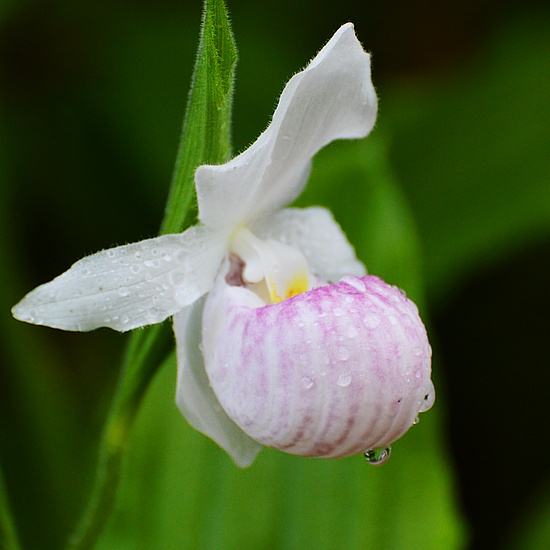
( More Showies )
On my past visit, Northern Waterthrush and Winter Wren sang in those swampy woods, hidden from view. This time I brought along my IPod to see if I could call them out with some recorded song. They both sang back fiercely (the loudest I've ever heard a Winter Wren sing, and that's saying something...) but were not forthcoming with good views. The wren perched in the shadows while searching for his (imaginary) rival, too poorly lit to photograph, while the waterthrush just darted over the trail from one hidden perch to another. It doesn't take much of this trickery, I find, before you start feeling like a right %&!*. So I discontinued playback, leaving each one confident that he had won and routed the intruder.
I had much better luck with another male waterthrush on a different territory. After only a brief few songs, he responded, first singing two hesitant notes ("uh, hello?") and then, after one more round from me, perching in view and singing away. Waterthrushes may be drab as warblers go, but they have long been among my favorite birds and I was delighted to finally get a photo of one.

And now for something completely different.

It was dragging that ball along through the vegetation. I think it's a wolf spider with her soon-to-be babies. Female wolf spiders are devoted mothers. After the spiderlings hatch, they will all crowd onto her back and travel with her wherever she goes.

I had to wade into a puddle to get some of those Showy photos. This fellow kept me company.

This small snake was basking on the trail. After some research, I learned that the markings on its head mean it's a Red-Bellied Snake. (I suspected at the time, but was unwilling to harass it into showing off its belly.) I'd only seen this species once before, and then it was in the beak of a kestrel. It is uncommon and usually rather shy. Like all of Ottawa's native snakes, it is harmless to humans.
A Price Worth Paying (part 3 of 3)
July 27th, 2017
(Part 1, Part 2)
It was near sunset when the best part of my day happened. It started with this:
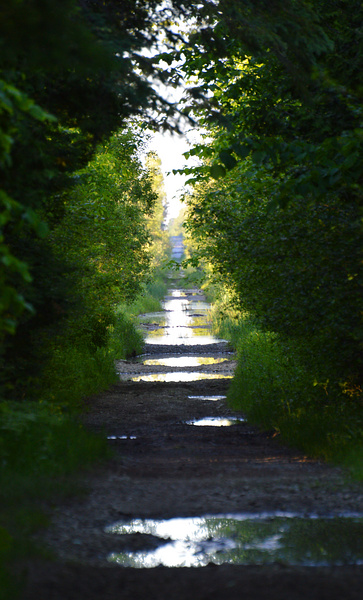
Abandon all hope of trail maintenance...
Okay, so turn back. It's time to get going anyway, get back to the car before dark...but there was just something so alluring about it. The flooded trail was somehow beautiful, beckoning. So I continued on, hoping that my shoes were as waterproof as they were advertised to be.
That continuing brought me to a colony of Showy Ladyslippers like nothing I'd ever seen. Not like the short, lonely, pale one I'd seen earlier, these were two feet tall, vividly colored and blossomed in clusters. There was nothing about them that would have been out of place in the most extravagant cultivated garden (if not for the fact that wild orchids almost never survive in gardens.) To stumble across such a sight alone, unaided, in the middle of nowhere...well, it's hard to do justice to it. The best I can put it is, imagine finding out that unicorns are real.



A relevant quote from Wildflowers of Ontario:
I'm not entirely convinced that this is a rare flower. The habitat which it prefers is simply not accessible to many people. [...] The only sane way to actually scout out this flower is to wear a bug jacket, a mosquito net over your head and latex gloves on your hands. I have never been bitten when I dress this way. I have, however, been accompanied by thousands of thirsty little mosquitoes as I look for this orchid. And that pretty well explains why most people have never seen a Showy Lady's Slipper, but it's worth the effort.
A Price Worth Paying (part 2 of 3)
July 21st, 2017
(Part 1, Part 3)
I tallied four separate singing Northern Waterthrushes over the course of my hike, the most I've ever heard in one day. (Saw none of them. Par for the course with Northern Waterthrushes.) And indeed, what I could see through the trees looked like waterthrush paradise, for much the same reason it was mosquito paradise: abundant, pristine standing water and gently flowing water. Somewhere in there, a little streaky brown bird was walking along the water's edge, tail bobbing, searching for aquatic insects and crustaceans or maybe even wading into the water to snap up minnows. But I could only imagine it, not see it.
After awhile I came to a spot where swampy woods gave way to a large, open wetland. It appeared a grassy marsh at first glance, but the presence of what looked like bog cotton suggested otherwise. These are the snowy-white tufts that blanket Mer Bleue bog in late spring and summer, giving the landscape a strange, almost alien beauty. They did not blanket this place, but that there were any of them was very suggestive. This was no mere marsh, and there might be things to see that I don't see often.

Bog Cotton?

It was on the margin of this wetland that I found my first in-bloom Showy Ladyslipper.
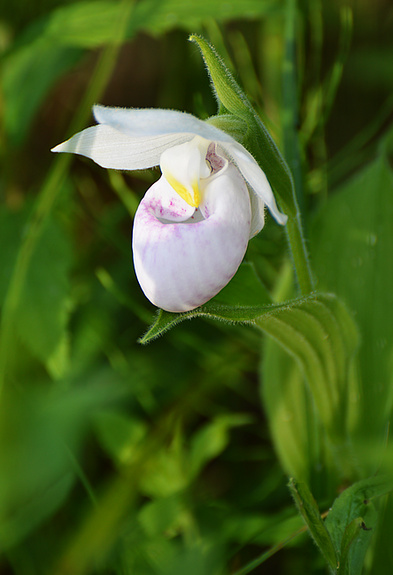
Showy Ladyslippers are somewhat variable wildflowers. They can grow up to two feet tall and may have striking, deep pink highlights on the white slippers. This one was on the small and pale side, but beautiful nonetheless. I was thrilled to find it. I searched for more, but it was the only one I could see. Its presence suggested that the wetland was in fact a fen (neutral-to-alkaline and fed by groundwater), which in turn suggested that the "Bog Cotton" was actually its relative, Slender Cottongrass. (I'm rather out of my depth here. I'd love to take a field botanist along with me on this hike!)

These little beauties also grew on the margins of the wetland. The very dark, purplish lateral petals mark them, I think, as a variation known as Small Yellow Lady's Slipper (Cypripedium parviflorum var. makasin). Compared to the larger and more common variety, these are about half the size and prefer wetter habitat, particularly fens and bogs.
A Price Worth Paying (part 1 of 3)
July 18th, 2017
(Part 2, Part 3)
Back to Marlborough Forest on June 14th. This time, instead of taking the usual loop around Roger's Pond, I decided to explore the vast network of forest roads. (By "vast", I mean that if you keep going down some of those roads, eventually you won't be in North Gower any longer. Snowmobilers use them.) It turned out to be a wetland wildflowers kind of day, with a big surprise at the end.

My route took me through swampy woods decked out with these magnificent Blue Flag irises. The first few were wilted and past-prime, but it seemed the further along I got, the better they got. Blue Flag inhabits a variety of wetlands, from marshes to wet meadows to streambanks.
My route also took me through mosquito paradise. (Their paradise. Not mine. So not.) One of the challenges of being a backwoods nature-watcher is that DEET literally melts plastic. I've already destroyed one set of binoculars with it and warped the focus ring on my zoom lens. On this day I managed to keep going without it for some time, through sheer bullheaded stubbornness, but eventually gave in. I'd rather let DEET slowly devour my equipment than let the mosquitos and deer flies slowly devour me.
At any rate, it was worth it. Marlborough Forest is a place where you learn that you can't have the beautiful parts of nature without the biting, stinging parts of nature. It's all one.

I received approximately 1,000,000 mosquito bites while taking this photo.

Common Buttercup

Hello. I understand that Cedar Waxwings like to eat flying insects. Could you please eat some of these flying insects? Kthx.


This was growing in standing water. My first thought was that the strangely-placed yellow clusters were some sort of foreign growth on the plant, but a closeup revealed the peduncles anchoring them to the stem. I couldn't find this one in my Peterson's field guide--which turned out to be because it wasn't in there, oddly enough. It's called Tufted Loosestrife. Unlike the familiar, invasive Purple Loosestrife (to which it is not closely related), it's a native North American wildflower that occurs only in natural wetlands.
Dragonflies Save The Day
July 11th, 2017
At Roger's Pond on June 12th, a sweltering hot day was drawing out the deer flies. They swarmed me, buzzing annoyingly (mostly not biting, but the ones that did left bites that still itched two weeks later.) But then the most marvelous thing happened...the cavalry arrived.

My hero
I walked into a wide-open sunlit spot that teemed with Chalk-Fronted Corporals (above), American Emeralds and other dragonflies, and in an instant they were all around me, picking off flies. I can think of few sounds more welcome and satisfying than that *whizz* of a dragonfly zipping past your head as it snatches its prey...a very loud noise followed by blessed silence.

One less deer fly!
It ended up being largely a dragonflies kind of day, as all the birds seemed to be sheltering from the heat.

American Emerald

This one caught my attention when it whizzed by and snatched a tiny insect that I was trying to photograph. Annoyance gave way to interest when I noticed how petite it was. I was hoping for an Elfin Skimmer, a dragonfly so small that it is sometimes mistaken for a bee. But it wasn't quite that petite. With the help of the Ottawa Odes group, I learned that it was my first Frosted Whiteface.

dragonfly habitat

Garter Snake
Birds and Orchids (part 2)
July 6th, 2017
(Part 1)
After our stop to see the Ram's Head Ladyslippers, we went to Murphy's Point Provincial Park in Perth. This is a beautiful park on the shore of Big Rideau Lake with a rather Carolinian feel to it (including, sad to say, a rather Carolinian population of ticks, I pulled one off me during our walk.) It produced our big surprise of the day. We were birding the Silver Queen Mine Trail when Jon shouted that there was a White Pelican in flight and to get our binoculars and cameras ready. I couldn't believe my ears--I thought he must be mistaken--but then I got a clear view of it. A White. Pelican. Little over an hour away from where I live.
My photos came out overexposed (the exposure having been set for a cute moth I was photographing close to ground, more on him later!) and I was bummed. But then, as if our jaws hadn't dropped enough, the pelican flew back into view and right over our heads. This time I was ready.
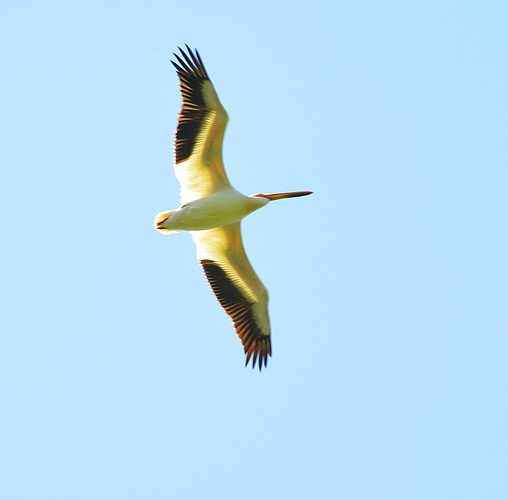
When we first arrived, the park staff asked us to let them know if we found any rarities for the park. We found not merely a rarity, but a bird that is a second-ever for all Lanark County, in recorded history. White Pelicans are a western species whose breeding range touches only the extreme western tip of Ontario. This would have been a very lost, late spring migrant! It is an Ontario-first and a second-ever bird for me.
Other than that, my photo set from this trip might better be termed "insects and orchids." I saw plenty of good birds, but most of them too far away for my lens to capture at all well. (I envy those with steady-enough hands to shoot 500mm handheld!)

A kind of adorable furry-headed moth I found on some low vegetation. I think it's an Agreeable Tiger Moth. (That being, of course, a close relative of the Disagreeable Tiger Moth and the Cantankerous Tiger Moth. Okay, maybe not.) A lifer insect for me, to go with my lifer wildflower (Ram's Head Ladyslipper), lifer reptile (Rat Snake), and pretty-darn-close-to-lifer bird!

A daddy longlegs, more properly called harvestman. Harvestmen are not spiders and are harmless to humans. I've loved them since I was a child.
Our final stop of the day was Purdon Conservation Area, famous for its thriving colony of a large, beautiful wild orchid, the Showy Ladyslipper. But we arrived to find the orchids not yet in bloom. The many tall shoots promised an incredible show once they are. I plan to go back on my own (and/or with Michael) in late June, when they should be at peak. The carnivorous Pitcher Plants were also not much to look at yet. But there were a few wildflowers worth photographing.
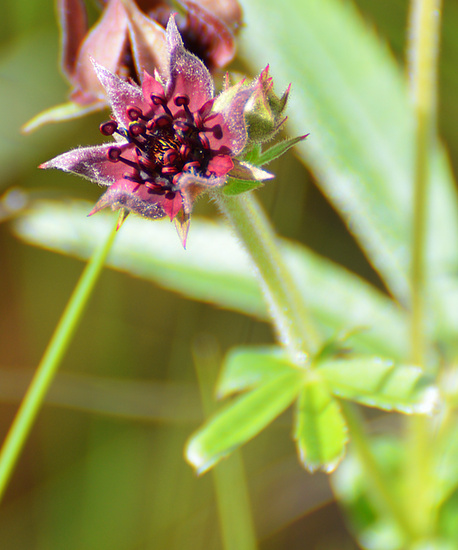
Swamp Cinquefoil

Starflower
I've noticed quite a few tent caterpillars in Ottawa this spring, but that's nothing compared to Lanark County. Sites we visited had an infestation of epic proportions, with tents and caterpillars everywhere you looked. In the trees, in the bushes, on the ground, on your backpack, on your head. The deposit box for park fees at Murphy's Point had a mass of a few dozen crawling atop it. At one spot on the trail, we heard a sound like gentle, pattering rain coming from the woods. I learned what it was the next day on Wikipedia. It was the sound of umpteen caterpillar fecal pellets falling from the treetops.
Tent caterpillars are shunned by most birds, spiny as they are, but the North American cuckoos (Black-Billed Cuckoo and Yellow-Billed Cuckoo) eat them with relish. Quoting from Life Histories of North American Birds by Arthur Cleveland Bent:
No caterpillars are safe from the Cuckoo. It does not matter how hairy or spiny they are, or how well they may be protected by webs. Often the stomach of the Cuckoo will be found lined with a felted mass of caterpillar hairs, and sometimes its intestines are pierced by the spines of the noxious caterpillars that it has swallowed. Wherever caterpillar outbreaks occur we hear the calls of the Cuckoos. There they stay; there they bring their newly fledged young; and the number of caterpillars they eat is incredible. [...] When, in time, the inside of the bird's stomach becomes so felted with a mass of hairs and spines that it obstructs digestion, the bird can shed the entire stomach-lining, meanwhile growing a new one.
Yes, really. Cuckoos are so specialized to a diet of spiny caterpillars that they have evolved the ability to shed and regrow their entire stomach lining.
So it was a surprise to not see a single one amidst this massive infestation! Not even in what looked like ideal habitat. I'd certainly seen more cuckoos this spring in Ottawa than ever before. Before I'd even noticed the caterpillars, the tents, before it was on the public's radar that we were having an infestation, the cuckoos had noticed. I saw a pair of them together at Nortel wetland in May, a third at Shirley's Bay the day after that. These are elusive birds; it is abnormal (wonderfully abnormal) to see so much of them! But our Lanark outing came up empty, the only two of our target species that we missed entirely. They were undoubtedly there, but remained unseen and unheard.
So I had to content myself with photographing the prey, not the predator.
( More (Tent Caterpillars, Northern Mockingbird, Upland Sandpiper) )
|
